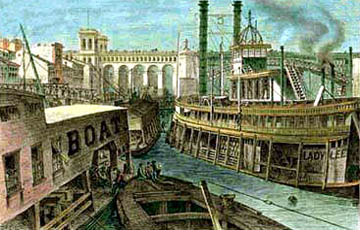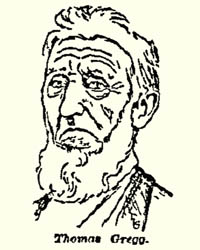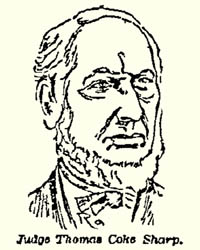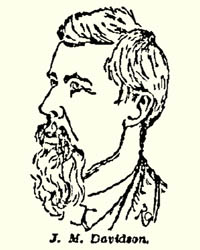
READINGS IN EARLY MORMON HISTORY
(Newspapers of Missouri)
Misc. St. Louis Newspapers
1850-1899 Articles

Steamboat Dock, Saint Louis, Missouri, (late 1850s)
1831-1840 | 1841-1843 | 1844-1849 | 1850-1899
Union Feb 01 '51 | Union Nov 06 '51 | DInt Apr 27 '54 | SLL Dec 30 '54
SLL Jan 27 '55 | SLL May 05 '55 | SLL Jun 02 '55 | SLN Jun 25 '55
DDem Aug 14 '56 | SLP Sep 13 '56 | DDem May 13 '57 | DDem Jun 12 '57
SLCA Sep 10 '57 | SLCA Nov 05 '57 | SLCA Nov 12 '57 | SLCA Nov 19 '57
SLCA Nov 26 '57 | SLCA Dec 17 '57 | SLCA Dec 24 '57 | SLSp Aug ? '84
SLGD Oct 06 '87 | SLRep Sep 30 '88 | SLGD Feb 21 '97
Articles Index | St. Louis Missouri Republican 1850s
 Vol. ? St. Louis, February 1, 1851. No. ? 
Interesting from the Great Salt Lake
For the following very interesting news, we are indebted to Mr. Monroe, of Great Salt Lake City: -- |
 Vol. ? St. Louis, November 6, 1851. No. ? 
From the Mormons
Among the passengers who arrived yesterday from the Missouri, in the Timour No. 2, were J. H. Kinkead, Esq., and Judge Reid, of the Supreme Court of the flourishing Territory of Utah. Mr. Kinkead and his party started for the States one day after the departure of the mail, which reached Independence several days ago. The news from the Territory is not of startling importance, yet we are glad to learn that its affairs were in the most prosperous condition. The crops had turned out admirably, and the agricultural class was, of course, in fine spirits. Trade of almost every description was remarkably brisk, and the regular merchants were exceedingly fortunate in being able to transact a large and remunerative business. In fact, there was no cry of hard times.... |
 Vol. ? St. Louis, Thurs., April 27, 1854. No. ?  Important Arrest. Day before yesterday, Mr. L. McCuen, Sheriff of Lee county, Illinois, arrived in this city in pursuit of a man by the name of William Smith, who was lately confined in Hancock county for highway robbery, but broke jail and fled to the county first mentioned. The rascal there became acquainted with a family in which were two girls, twin sisters, of comparatively tender age. There he committed the double crime of seducing one of the sisters, and perpetrating a rape upon the other, and fled to this city. The Sheriff, obtaining the assistance of officers Grant and Guyott, after a thorough search succeeded in arresting him about ten o'clock on Wednesday night, on Market street. The Sheriff left immediately to return to Illinois with his prisoner. -- The latter is forty-five years of age, and said to be a man of desperate character. |
 Vol. I. St. Louis, December 30, 1854. No. 6.  Incidents in the History of Joseph Smith. G. S. L. City, Utah, Oct. 9, 1854. |
 Vol. I. St. Louis, January 27, 1855. No. 10.  WILLIAM SMITH. We have received a pamphlet published by this individual, vindicating himself in a characteristic style from certain charges of licentiousness, for which he has been held to answer before the courts of Illinois. We also received not long since, an article intended for the Luminary, accompanied by a personal letter from him, professing much piety and zeal for the cause of God. Several correspondents have also made reference to and asked questions about him. It is with regret that we feel thus called upon to make any reference to him whatsoever. We can only think of him with feelings of pity and of shame for poor human nature, and we could wish that many incidents of his life were obliterated from our memory. It appears that he still has, or affects to have, a few followers in Lee county, Ill. The character of his followers or associates may be readily conjectured by those who are acquainted with him. For the information of such as are in the habit of confounding them with Latter-day Saints, and of such uninformed Saints as may be exposed to his deceptions, we would state that he was excommunicated from the Church of Jesus Christ of Latter-day Saints by the General Conference, held in the temple at Nauvoo, in the fall of 1845, and has had no fellowship or connection with said church since that time, and the conditions alone on which he ever could be restored to fellowship, are, to humble himself as a little child, and enter in at the door, bringing forth fruits mete for repentance. This he knows full well, and until he does so, all who believe the gospel and value their salvation, will stand far removed from him and all his hypocritical presentations and unhallowed administrations. |
 Vol. I. St. Louis, May 5, 1855. No. 24. 
|
 Vol. I. St. Louis, June 2, 1855. No. 28. 
|
 Vol. I. St. Louis, Missouri, June 25, 1855. No. 47?  A Mormon Woman in Distress -- The Working of Polygamy There is a woman now in St. Louis who has been made a victim of Mormonism, to whom we desire to invite the attention, and in behalf of whom we wish to enlist the sympathy of the philanthropic. Her name is Mrs. Parsons. Ten years ago she was living happily with her husband, who was a clever shoemaker, in London, comfortable in circumstances, and blessed with domestic peace. About that time the husband became a convert to Mormonism, under the influence of the preaching of the proselites of the Church of Latter Day Saints, who were strolling over England and Wales. Of course, his wife received and embraced the faith, too -- the abominable doctrine of polygamy being sturdily denied by those who pretended to be the orthodox expounders of the creed. Her husband abandoned his trade and turned preacher, traveling over France and England to disseminate the Mormon doctrines. Of course the wife was left pretty much to shift for herself and her young children. Things went on till she came to America, about a year ago, on her way to Utah with a company of Mormon emigrants. Her husband remained in Europe to superintend the embarkation of other emigrants, and promised to meet her in St. Louis. When the poor woman arrived here, she found no provision made for her support, and no arrangements for her passage across the plains. She was therefore compelled to seek employment to earn a scanty support for herself and her starving children. By stitching shoes she managed to live through the winter, and in the spring her husband arrived, and proceeded forthwith up the Missouri tover to the Mormon encampment at Atchison, in Kansas Territory, commanding her to follow. Devoted in her attachment to her brute of a husband, and trusting sincerely in the Mormon faith as represented to her, she embarked on another boat, and reached Atchison, in quest of her husband. Then she found him living in a tent with two women, to whom he had been spiritually "sealed." Her feelings and condition may be better imagined than described. She was crushed and heartbroken. She tried to induce the brute to abandon his mistresses and protect her, but she was spurned by him, who intimated that she must shift for herself. She represented her case to the ecclesiastical chief, on the ground, and urged him to see her righted, but that precious disciple told her that she was a stiff-necked reprobate, stinking in the nostrils of every good Mormon. Heartbroken and despairing, she took her two children and made her way from the camp, five miles to Atchison, where she stated her case to a generous citizen. He promised to protect her with his life, and aided her in getting on board the F. X. Aubry, then on her way down the river. She had but three dollars, which she offered to the captain for her passage to St. Louis, but he, like a generous man that he is, brought her down for nothing. |
 Vol. ? St. Louis, August 14, 1856. No. ? 
... TWO MUMMIES from the Catacombs of Egypt, which have been unrolled, presenting a full view of the RECORDS enclosed, and of the bodies which are in a remarkable state of preservation... |
 Vol. III. St. Louis, Mo., September 13, 1856. No. 34.  The St. Louis Museum. This Museum for natural history, on Market street, opposite the Court House, Wyman’s Hall, is one of the most remarkable improvements of our city and country. Astonished as I was to meet with such a store of public instruction, far from the aged Europe and the elder East of America, I feel obliged to call attention to it; not for the purpose of enriching the present proprietor with a few twenty-five cent pieces, but because no sensible man will leave it [without]....(missing lines in clipping) |
 Vol. ? St. Louis, May 13, 1857. No. ? 
JO. SMITH'S MUMMIES. -- About a year since, Mr. Wyman of the museum, purchased two mummies, one of each sex, from a gentleman who had purchased them directly from the widow of Jo. Smith. They were part of the four which Smith pretended to have found with ancient manuscripts, edited by the old patriarchs. While the mother of Smith lived, these mummies, with the hyeroglyphics upon papyrus which accompanied them, could not be obtained, but not long after her death they were purchased, as stated, from the prophet's widow. Some of the brethren have had the hardness to deny that these were the patriarchal manuscripts and relics. But an unanswerable confirmation of the fact has lately occurred; certain plates issued by the elders as fac-similies of the original having fallen into Mr. Wyman's hands, which plates are fac-similies of the hyeroglyphics in the museum. Let, then, all of Mormon faith go to the museum, and contemplate the veritable handwriting of the patriarch Abraham. Who knows that the patriarch himself, "and Sarai his wife," are not in the museum? |
 Vol. ? St. Louis, June 12, 1857. No. ? 
THE MORMON PROPHET'S MUMMIES. -- Not long since, we stated that the mummies and accompanying Egyptian manuscripts at the museum were the identical mummies and manuscripts formerly found by Smith the mormon prophet. They were purchased by the proprietor of the museum from Mr. A. Combs, who bought them at Nauvoo city on the 26th of May, 1856. In a work published by "the saints" is a facsimile of the manuscripts with the information added that they were written by the great Jewish patriarch, Abraham himself. Doubt having still been expressed that they were the prophet's mummies, etc., we now append the certificate with which the sale of them to Mr. Combs was accompanied. Here it is: |
 Vol. VII. - No. 4. St. Louis, September 10, 1857. Whole 316. 
(For the St. Louis Christian Advocate)
Mr. Editor: Did you ever visit this rare collection of the curiosities of nature and art? ... the object most attractive to me was the Egyptian mummies. These unfolded a history deeply interesting to every lover of the curious and antiquated. It is said that these mummies were obtained in the catacombs of Egypt sixty feet below the surface of the earth, for the Antiquarian Society of Paris, and forwarded to New York, and there purchased by Joseph Smith, the Mormon prophet, in 1835; and that he used them in practicing his deceptions upon the people, pretending to translate the writings or hieroglyphics found in the chest of one of them, stating that they belonged to the family of Pharaoh. I suppose this great impostor, among other things equally glaring, confirmed his prophetic authority by alleging this papyrus roll to contain a commission to him from Pharaoh. By this, or some other mysterious power, he evidently holds in strange captivity many deluded people who groan to be delivered from bondage. Prof. Seyffarth says this writing contains an invocation to the Deity Osirus, in which occurs the name of the person, which is Horus. Long did I gaze upon these relics of departed greatness. Three thousand years have told upon the fortunes of the world since they mingled in the busy scenes of strife and acted their part upon the world's theatre. Could they but read the mighty change! "Great Pharaoh's sceptered pride" has departed. The refinements and luxuries of Egypt in the days of her glory have faded. Its wealth and power are gone. Where stood the mightiest empire on the earth, now stretches out drear and desolate plains, filled here and there with huge piles of mouldering ruins, monuments of departed greatness. Where palaces, and temples, and cities stood in the days of Pharaoh's glory and Egypt's power, now ruin sways its sceptre, and the curious tourist and scientific antiquarian study its hyeroglyphics, ramble amid its decaying arches, and pillars, and obelisks, gaze upon its pyramids and penetrate its catacombs and exhume its mummied Pharaohs, to tell the story of departed grandeur and glory, and point to the wisdom of Moses in choosing rather affliction with God's people and the imperishable glory of an everlasting reward. W. M. L. |
 Vol. VII. - No. 12. St. Louis, November 5, 1857. Whole 323.  LATER FROM CALIFORNIA. ... The Mormons were to leave Carson Valley on the 25th of October. Brigham Young had ordered them to form a secret cavalry company, equipped with a year's provision and clothing.... |
 Vol. VII. - No. 13. St. Louis, November 12, 1857. Whole 324. 
WASHINGTON. -- Brigham Young, in a communication to the Indian Bureau, says that if he is to have the direction of Indian affairs, and is expected to maintain friendly relations with the Indians, he would suggest that travelers should omit the infamous practice of shooting them when they happen to see them; hence it is natural that they wreak their vengeance in retaliation. The Government, he says, should make more liberal presents, for he has proven that it is far cheaper to feed and clothe the Indians than to fight them -- for when fighting is over it is always followed by expensive presentsm, which if properly distributed in the first place, might have averted the fight. The troops, he also says, must be kept away, for the more of these there are there we might expect to find the greater amount of hostile Indians, and the least security to persons and property. |
 Vol. VII. - No. 14. St. Louis, November 19, 1857. Whole 325. 
ATTACK ON THE GOVERNMENT TRAINS. -- The Lexington (MO.) Expositor has the following in reference to the destruction of the army supplies by the Mormons: |
 Vol. VII. - No. 15. St. Louis, November 26, 1857. Whole 326. 
THE MORMON TROUBLES are increasing. It is now pretty generally believed, that the recent terrible massacre of over one hundred California emigrants was instigated by them. Should this be proven true, there is scarce any punishment they do not deserve. The recital of the depredations committed by the Indians at the instigation of the Mormons, if indeed it were not done by Mormons in the disguise of Indians, is horrible. There is much trouble ahead in reference to these infatuated and very bad people. |
 Vol. VII. - No. 18. St. Louis, December 17, 1857. Whole 329. 
TUESDAY, 15. -- The news received by telegraph yesterday was of an interesting and important character. |
 Vol. VII. - No. 19. St. Louis, December 24, 1857. Whole 339. 
The news from Utah, by the way of Washington city, is that the Mormons have expressed their determination to resist the advance of the United States troops, and that it was by Brigham Young's order that the Government trains were recently burnt. |
 Vol. ? St. Louis, Missouri, August ?, 1884. No. ? 
THE BOOK OF MORMON.
How many people know anything about the origin of the Mormon religion, or rather, of the Book of Mormon, which is its authority? I knew precious little about it until this week, when I accidently fell in with Mr. Clark Braden, who has recently given the subject a most searching investigation. His story shows of what stuff a religion may be made. The Mormons number probably 800,000. They are divided into many sects, but the principal are the polygamous Brighamites in Utah and the non-polygamous Josephites scattered in various places. The story may be given in a few words. The Book of Mormon was written by an old broken down Presbyterian clergyman named Solomon Spaulding. Spaulding was born in Connecticut in 1761. He graduated at Dartmouth college, and settled as minister for a Congregational church. He made a sad failure at preaching, and went into business with his brother in New York state, did not succeed, and started up an iron foundry in a town in northern Ohio. He soon failed in that venture and became very much discouraged. His wife supported the family by taking boarders, and he spent his time writing, though what did not then appear. He afterwards rewrote the entire book, adding a third part. This is the origin of the manuscript. |
 Vol. ? St. Louis, Mo., October 6, 1887. No. ? 
THE HAUN'S MILL MASSACRE. Breckenridge, Missouri, September 27, 1887. -- In the afternoon of Tuesday, October 30, 1838, during the Mormon war in Missouri, there occurred in Caldwell County a dreadful incident, generally termed 'The Haun's Mill Massacre.' From official documents and other records, from affidavits of witnesses, and from statements made by actual participants, I have prepared the following account. If any newspaper publication of the affair has ever before been made, I am not aware of the fact. |
 Vol. 71. St. Louis, Mo., Sunday, September 30, 1888. No. 21,295. 
THREE PIONEER EDITORS. Carthage, Ill., Sept. 27 -- Probably no State in the Northwest can boast of as many pioneer country editors as does Illinois. There are many unknown to history, for the proverbial modesty of the profession has kept them in obscurity. Three of the oldest editors in this State are Thomas Gregg of Hamilton, Ill.; Judge Thomas Coke Sharp of the Carthage Gazette and J. M. Davidson of the Carthage Republican. |
 Vol. ? St. Louis, Mo., February 21, 1897. No. ? 
MORMONISM'S BEGINNING.
San Jacinto, Cal., Feb. 2. -- Daniel Hendrix, one of the two persons now living who were associated with the members of the earliest Mormon Church at Palmyra. N. Y., lives at the home of his son in this vicinity. He is 87 years of age, and retains his full mental faculties. Although a disbeliever in any part of the Mormon faith, he is often visited by descendants of Joseph Smith and of Sidney Rigdon, the founders of Mormonism, for reminiscences of the early days of the Latter Day Saints in Wayne County, N.Y. Edgar Smith, a grandson of Joseph Smith, told the writer less than a year ago that he found Daniel Hendrix, the last man living who had the closest personal acquaintance with his grand-parent at the time of the finding of the golden Bible. |
Back to top of this page.
Newspaper Articles | Articles Index | History Vault
Oliver's Bookshelf | Spalding Library | Mormon Classics
last updated: Feb. 3, 2013


